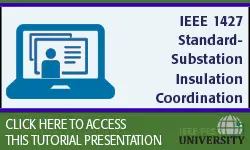-
Members: FreePES
IEEE Members: $25.00
Non-members: $40.00Length: 00:42:08
Panel
12 Sep 2022
This panel session video contains the following presentations:
1. Electromagnetic Transient Simulation Research on Operation Characteristics of Power Grid with Large-Scale New Energy
Accelerating the connection of wind power, photovoltaic and other new energy units to the grid and increasing the supply of clean electricity will not only ease the tension between power supply and demand, but also help achieve the goal of "carbon peak and carbon neutral" and promote the low-carbon energy transition. New power system presents more and more technical characteristics of high proportion of renewable energy and high proportion of power electronic equipment. The internal mechanism of its stability changes, which brings new challenges to security and stability analysis and simulation modeling calculation of power system. EMT simulation has obvious advantages in simulating the operation characteristics of large-scale power grid with high proportion of power electronic equipment. Based on the new generation of digital-analog hybrid simulation platform in State Grid Simulation Center, a detailed EMT real time simulation model of large power grid with large-scale new energy delivered through UHVDC is built. In the simulation tests of continuously increasing the proportion of new energy access, the problems of system oscillation and operation instability are found. Through real-time simulation tests and theoretical analysis to co-locate the problem, this paper proposes a measure to increase the proportion of new energy connected to the power grid by reasonably configuring the synchronous condenser. The problems of system oscillation and instability are solved by adopting this measure to the example power grid. Simulation results show that this measure can improve the stability of power system with large-scale new energy and effectively increase the proportion of new energy connected to the power grid.
2. Digital-Analog Hybrid Simulation of Renewable Energy Sent to Large-Scale AC Power Grid Through Zhangbei VSC-HVDC System
Zhangbei demonstration project is a typical case of large-scale renewable energy sending out through VSC-HVDC. It provides a feasible way for the transmission and utilization of renewable energy in Zhangbei area. Considering the large number of power electronic equipment in renewable energy power plants and VSC-HVDC systems, the potential risks of various types of oscillations exist. Previous studies have mostly focused on the renewable energy side. The research on the dynamic stability characteristics of large-scale power grid at the receiving end is relatively few. According to the operation data of North China Power Grid in 2021, a detailed EMT real-time simulation model of Zhangbei flexible DC transmission grid is built based on HYPERSIM, including renewable energy base, Zhangbei VSC-HVDC transmission project and large-scale AC power grid. Taking the super parallel computer SGI as the core equipment, the actual control and protection devices same as the project site is connected to the proposed model. Detailed simulation is carried out, for the faults near the renewable energy base, VSC-HVDC grid and AC power grid respectively. The AC / DC response in the process of fault and recovery is studied. Especially, a safety and stability control measure is taken for some AC side faults with poor recovery characteristics to ensure the safty and stability of the receiving power grid. The simulation results provided technical support for the commissioning test during operation.
3. Exploratory Study of Grid-Connected Photo-Voltaic System Operational Impacts on a Real Utility MV Distribution Network
The nature of the modern grid is rapidly changing with the increasing penetration of PV at MV and LV levels. This rising penetration reduces the dependency on conventional energy resources and leads to several issues that have not been seen by distribution system operators (DSOs) previously. This paper presents an exploratory study to investigate the impact of PV integration on an actual utility MV distribution feeder. \textcolor{black}{The impact of PV integration on power quality is studied using measurements from the power quality analyzers placed at different substations.} Moreover, the feeder simulation model is developed and validated with real PQA and SCADA data under similar loading conditions. Finally, the impact of PV on the network voltages and currents has been studied using the developed simulation model under various operating conditions to analyze the effect of PV integration on the distribution network.
1. Electromagnetic Transient Simulation Research on Operation Characteristics of Power Grid with Large-Scale New Energy
Accelerating the connection of wind power, photovoltaic and other new energy units to the grid and increasing the supply of clean electricity will not only ease the tension between power supply and demand, but also help achieve the goal of "carbon peak and carbon neutral" and promote the low-carbon energy transition. New power system presents more and more technical characteristics of high proportion of renewable energy and high proportion of power electronic equipment. The internal mechanism of its stability changes, which brings new challenges to security and stability analysis and simulation modeling calculation of power system. EMT simulation has obvious advantages in simulating the operation characteristics of large-scale power grid with high proportion of power electronic equipment. Based on the new generation of digital-analog hybrid simulation platform in State Grid Simulation Center, a detailed EMT real time simulation model of large power grid with large-scale new energy delivered through UHVDC is built. In the simulation tests of continuously increasing the proportion of new energy access, the problems of system oscillation and operation instability are found. Through real-time simulation tests and theoretical analysis to co-locate the problem, this paper proposes a measure to increase the proportion of new energy connected to the power grid by reasonably configuring the synchronous condenser. The problems of system oscillation and instability are solved by adopting this measure to the example power grid. Simulation results show that this measure can improve the stability of power system with large-scale new energy and effectively increase the proportion of new energy connected to the power grid.
2. Digital-Analog Hybrid Simulation of Renewable Energy Sent to Large-Scale AC Power Grid Through Zhangbei VSC-HVDC System
Zhangbei demonstration project is a typical case of large-scale renewable energy sending out through VSC-HVDC. It provides a feasible way for the transmission and utilization of renewable energy in Zhangbei area. Considering the large number of power electronic equipment in renewable energy power plants and VSC-HVDC systems, the potential risks of various types of oscillations exist. Previous studies have mostly focused on the renewable energy side. The research on the dynamic stability characteristics of large-scale power grid at the receiving end is relatively few. According to the operation data of North China Power Grid in 2021, a detailed EMT real-time simulation model of Zhangbei flexible DC transmission grid is built based on HYPERSIM, including renewable energy base, Zhangbei VSC-HVDC transmission project and large-scale AC power grid. Taking the super parallel computer SGI as the core equipment, the actual control and protection devices same as the project site is connected to the proposed model. Detailed simulation is carried out, for the faults near the renewable energy base, VSC-HVDC grid and AC power grid respectively. The AC / DC response in the process of fault and recovery is studied. Especially, a safety and stability control measure is taken for some AC side faults with poor recovery characteristics to ensure the safty and stability of the receiving power grid. The simulation results provided technical support for the commissioning test during operation.
3. Exploratory Study of Grid-Connected Photo-Voltaic System Operational Impacts on a Real Utility MV Distribution Network
The nature of the modern grid is rapidly changing with the increasing penetration of PV at MV and LV levels. This rising penetration reduces the dependency on conventional energy resources and leads to several issues that have not been seen by distribution system operators (DSOs) previously. This paper presents an exploratory study to investigate the impact of PV integration on an actual utility MV distribution feeder. \textcolor{black}{The impact of PV integration on power quality is studied using measurements from the power quality analyzers placed at different substations.} Moreover, the feeder simulation model is developed and validated with real PQA and SCADA data under similar loading conditions. Finally, the impact of PV on the network voltages and currents has been studied using the developed simulation model under various operating conditions to analyze the effect of PV integration on the distribution network.
Chairs:
Prof Jasronita


